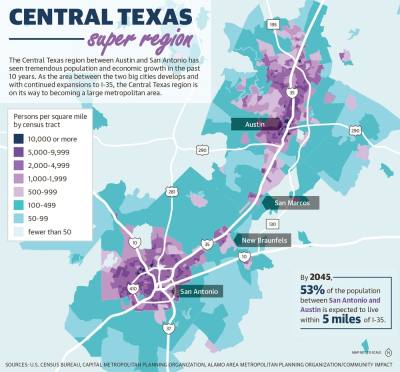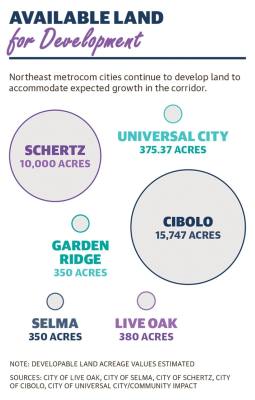By 2045, 53% of the population between San Antonio and Austin is expected to live within 5 miles of I-35, according to a 2019 study by the Capital Area Metropolitan Planning Organization and the Alamo Area Metropolitan Planning Organization.
In this study, the two organizations analyzed growth in the counties between San Antonio and Austin.
By 2060, Bexar County is projected to reach a population of more than 2.6 million, and Travis County is expected to reach more than 1.7 million, according to data from the Texas Demographic Center.
To accommodate rapid population growth—and with it rapid traffic growth— Greater Austin-San Antonio Corridor Council President Ross Milloy said investments in roads and alternative transportation, such as electric vehicles and rail, will need to be prioritized.
“I think we are going to have to rely on trying to beef up high capacity transit between Austin and San Antonio,” Milloy said.
From 2022-60, Hays County is projected to have a 105% increase in population, while Comal County is projected to increase by 74%, and Guadalupe County by 47%, according to data from the TDC.
Jordan Matney, New Braunfels assistant city manager, said the position of cities on the I-35 corridor has influenced its economic growth and development.
“I think when I-35 traverses your city, you’re sort of primed for growth,” Matney said. “I think the entire state of Texas is seeing a large amount of growth within the last 10-20 years. And a lot of those cities on the I-35 corridor ... have seen some rapid development.”
Connecting the corridor
Alongside population increases, traffic will increase throughout the corridor, and businesses will continue to move in, leaving organizations, such as AAMPO and CAMPO, to plan ahead and prioritize future road projects.
Laura Lopez, the San Antonio district public information officer for the Texas Department of Transportation, said the organization is working to address future traffic growth and congestion on I-35.
Each day, 100,000-150,000 vehicles use the section of I-35 between San Antonio and Austin. Many of these vehicles are carrying people commuting on a daily basis, Lopez said.
TxDOT projects include the I-35 Northeast Expansion (NEX), which is a three-part project that will add elevated lanes and additional lanes on the interstate.
The central portion of the project broke ground in May and will add 9.5 miles of elevated nontolled lanes from Loop 410 North to FM 3009, Lopez said.
This $1.5 billion project is part of the Texas Clear Lanes initiative, which focuses on addressing congestion throughout the state. The project is expected to be completed in 2027.
In 2024, TxDOT will begin work on I-35 NEX South, which runs from North Walters Street to Loop 410 North.
The final portion of the three-part project will be I-35 NEX North, which will focus on I-35 between FM 3009 and FM 1103. This project is unfunded, Lopez said.
Lopez said future travel times are expected to improve by 41%-48% on I-35 from FM 3009 to the AT&T Center, which is 15.5 miles.
“Without the I-35 NEX project, travel time is about 29 minutes on the main lanes of I-35,” she said. “With the I-35 NEX project, travel time will be 17 minutes on the main lanes and 15 minutes on the elevated lanes.”
Traversing the future
In 1984, the Greater Austin-San Antonio Corridor Council, a regional nonprofit public-private partnership, was created to support long-term infrastructure and economic development for the corridor.
Corridor Council President Ross Milloy said $10 billion will be put into I-35 growth over the next five to 10 years from planned projects alone.
In 2016, the Lone Star Rail District, which was to be a commuter rail between Austin and San Antonio, died after a vote from CAMPO. But Milloy said he believes the idea of rail is likely to return.
“I still think that a rail connection between Austin and San Antonio is necessary and inevitable,” he said. Another organization, San Antonio-based VIA Metropolitan Transit, is in the early stages of starting a pilot program—once funding is secured—that will provide public bus routes between the two cities with stops in San Marcos and New Braunfels.
Other concerns for the corridor—especially within Austin and San Antonio—are water and air quality, Milloy said.
Should the two cities move into nonattainment—or “smog city” classification due to ground-level ozone measurements—it would lead to restrictions on development and could lead to inspection fees across Bexar County, Milloy said.
To help fight pollution, the Electric Transportation Compact was created in 2020 and tasked with responding to the leading cause of air pollution in the South Central Texas region.
The organization is working with Bexar and Travis counties to upgrade fleets to electric vehicles.
Economic growth
San Antonio Mayor Ron Nirenberg said the corridor growing into a metroplex is an inevitability.
“My hope is that in the process, the two cities become better versions of themselves and specifically San Antonio continues to grow into a more inclusively prosperous place that retains its unique cultural heritage,” Nirenberg said.
He would also like the city to look toward connectivity between the east and west sides, Nirenberg said.
“With progress on the north-south line well underway, it’s time to look even further into the future and plot a course for a corridor connecting east and west San Antonio—and elevate the potential of historically underserved areas,” he said.
As Austin and San Antonio continue to thrive and prosper, the cities in between must race to keep up with demand.
Jonathan Packer, president and CEO of the Greater New Braunfels Chamber of Commerce, said he thinks the Austin-San Antonio region has a lot of the characteristics that make up a strong metroplex, such as two international airports, highway connection and economic development in unique business sectors.
“I think one other hallmark that’s really important where we have more work to do is just on the general collaboration between the two cities and the other cities in the region,” Packer said. “So I think that’s an area that—as we look to the future—cities learning to work together more intentionally and collaboratively as a region is the next wave that I look forward to seeing.”
Traversed by and adjacent to the I-35 corridor are Hays and Caldwell counties, which are overseen by the Greater San Marcos Partnership.
“All the communities within those two counties are all partners in the [GSMP], so our intent is to bring the jobs, and for the last three years ... we have basically been breaking every record the organization’s ever set in terms of hitting that mission,” GSMP President and CEO Jason Giulietti said.
The GSMP has brought in more than $2 billion of new investments to its communities, which directly translates to thousands of jobs, Giulietti said.
Metrocom development
In the San Antonio metrocom, the cities of Schertz, Cibolo, Selma, Universal City and Live Oak continue to grow alongside the corridor.
Schertz and Cibolo have the most room for growth, with Schertz planning for commercial development in the northern part of the city along I-35, according to Schertz Economic Development Corporation officials.
On Dec. 6, Schertz City Council discussed the rezoning of 75 acres of land southeast of Cibolo Valley Drive and I-35.
This project would add commercial and retail development along I-35, alongside a multifamily development with an entrance to Cibolo Valley Drive, Assistant City Manager Brian James said.
Place 1 Council Member Mark Davis said this project will add to the value of the city.
“I think the concept is fantastic overall,” he said. “I think it is definitely going to fill the need for our community as we grow into that northern sector.”
While this project has made it through a first read- ing, there is no estimated start date.
The landlocked cities, Live Oak, Selma, Universal City and Garden Ridge, have less room, but are working to fill out the properties within their boundaries.
In Live Oak, electrical contractor Alterman broke ground on a new 200,000-square-foot campus at 7653 N. Loop 1604 E., Live Oak. It has a completion date of January 2024.
City Manager Glen Martel said the city is working on transportation projects and promoting growth that benefits residents.
“We want Live Oak to be a city where you can live, work and play,” he said.
Selma is approaching full build-out within the next 15 years and is focusing on industrial growth, City Administrator Johnny Casias said.
University Health plans to put a new hospital at the corner of Retama Parkway and Lookout Road.
This project is expected to bring in ancillary businesses, Casias said.
While University Health has not announced a timeline for this project, the city plans to begin a road project on Retama Parkway to prepare for the new development.
Each city is working with developable land in different ways, with the cities of Schertz and Cibolo each having more than 15,000 acres to develop.
Cibolo Economic Development Director Kelsee Jordan Lee said this gives the city a lot of room to accommodate new growth and new residents.
”We have a lot of room to welcome new residents and businesses to Cibolo,” she said.










